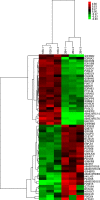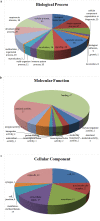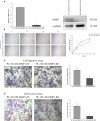Proteomic analysis of human prostate cancer PC-3M-1E8 cells and PC-3M-2B4 cells of same origin but with different metastatic potential
- PMID: 30379883
- PMCID: PMC6209233
- DOI: 10.1371/journal.pone.0206139
Proteomic analysis of human prostate cancer PC-3M-1E8 cells and PC-3M-2B4 cells of same origin but with different metastatic potential
Abstract
Prostate cancer (PCa) is the second most frequently diagnosed cancer and the fifth leading cause of death from cancer in men worldwide. Increased understanding of the prostate cancer metastasis mechanisms will help identify more efficient intervention strategies to prevent or treat this deadly disease in the future. To identify the candidate proteins that contribute to metastasis of PCa, isobaric tags for relative and absolute quantitation (iTRAQ)-based proteomic analysis was performed to explore differentially expressed proteins between two homologous human prostate cancer cell lines including highly-metastatic PC-3M-1E8 cell line and poorly-metastatic PC-3M-2B4 cell line. Here, a total of 58 proteins were identified to be significantly differentially expressed between PC-3M-1E8 and PC-3M-2B4 cells, which were further verified using real-time quantitative PCR and western blot analysis. The bioinformatic analysis suggested that the differentially expressed proteins, like MMP1 and FHL1, may contribute to the higher metastatic ability of PC-3M-1E8 cells than PC-3M-2B4 cells. In addition, functional analyses proved MMP1's positive effect on the higher metastatic ability of PC-3M-1E8 cells than PC-3M-2B4 cells. These findings provided a unique resource to specifically reveal the complex molecular regulatory mechanisms underlying the progression of prostate cancer from poorly-metastatic to highly-metastatic stage.
Conflict of interest statement
The authors have declared that no competing interests exist.
Figures













Similar articles
-
[Screening of phosphoprotein associated with glycosphingolipid microdomains 1 (PAG1) by cDNA microarray and influence of overexpression of PAG1 on biologic behavior of human metastatic prostatic cancer cell line in vitro].Zhonghua Bing Li Xue Za Zhi. 2010 Feb;39(2):88-94. Zhonghua Bing Li Xue Za Zhi. 2010. PMID: 20388373 Chinese.
-
[Effects of vimentin on invasion and metastasis of prostate cancer cell lines PC-3M-1E8 and PC-3M-2B4].Ai Zheng. 2008 Jan;27(1):30-4. Ai Zheng. 2008. PMID: 18184460 Chinese.
-
Identification of reciprocal microRNA-mRNA pairs associated with metastatic potential disparities in human prostate cancer cells and signaling pathway analysis.J Cell Biochem. 2019 Oct;120(10):17779-17790. doi: 10.1002/jcb.29045. Epub 2019 May 24. J Cell Biochem. 2019. PMID: 31127646
-
Four and a half LIM domains protein 1 can be as a double-edged sword in cancer progression.Cancer Biol Med. 2020 May 15;17(2):270-281. doi: 10.20892/j.issn.2095-3941.2019.0420. Cancer Biol Med. 2020. PMID: 32587768 Free PMC article. Review.
-
Molecular and cellular changes associated with the acquisition of metastatic ability by prostatic cancer cells.Prostate. 1994 Nov;25(5):249-65. doi: 10.1002/pros.2990250505. Prostate. 1994. PMID: 7971516 Review.
Cited by
-
Proteomic Landscape of Prostate Cancer: The View Provided by Quantitative Proteomics, Integrative Analyses, and Protein Interactomes.Cancers (Basel). 2021 Sep 27;13(19):4829. doi: 10.3390/cancers13194829. Cancers (Basel). 2021. PMID: 34638309 Free PMC article. Review.
-
A Novel Tanshinone Analog Exerts Anti-Cancer Effects in Prostate Cancer by Inducing Cell Apoptosis, Arresting Cell Cycle at G2 Phase and Blocking Metastatic Ability.Int J Mol Sci. 2019 Sep 10;20(18):4459. doi: 10.3390/ijms20184459. Int J Mol Sci. 2019. PMID: 31510010 Free PMC article.
-
FHL1 Overexpression as A Inhibitor of Lung Cancer Cell Invasion via Increasing RhoGDIß mRNA Expression.Cell J. 2022 May;24(5):239-244. doi: 10.22074/cellj.2022.8031. Epub 2022 Apr 27. Cell J. 2022. PMID: 35717564 Free PMC article.
-
Recent Developments and Applications of Quantitative Proteomics Strategies for High-Throughput Biomolecular Analyses in Cancer Research.RSC Chem Biol. 2021 Aug;4(4):1050-1072. doi: 10.1039/d1cb00039j. Epub 2021 May 19. RSC Chem Biol. 2021. PMID: 34430874 Free PMC article.
-
MicroRNA-92a Targets SERTAD3 and Regulates the Growth, Invasion, and Migration of Prostate Cancer Cells via the P53 Pathway.Onco Targets Ther. 2020 Jun 12;13:5495-5514. doi: 10.2147/OTT.S249168. eCollection 2020. Onco Targets Ther. 2020. PMID: 32606766 Free PMC article.
References
Publication types
MeSH terms
Substances
LinkOut - more resources
Full Text Sources
Medical
Research Materials

